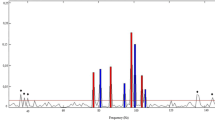Abstract
The goal of our study was to identify the role of auditory steady-state responses for hearing assessment in patients with functional hearing loss. The study design was to compare auditory steady-state response thresholds and standard pure-tone audiometry thresholds between patients with functional or sensorineural hearing loss. Subjects comprised 16 patients (24 ears) with functional hearing loss and 17 patients (24 ears) with sensorineural hearing loss. Differences and correlations between auditory steady-state response thresholds and standard pure-tone audiometry thresholds at 500, 1,000, 2,000 and 4,000 Hz were evaluated. In children with functional hearing loss, pure-tone audiometry thresholds and auditory steady-state response thresholds were significantly different at all frequencies and were not significantly correlated. In patients with sensorineural hearing loss, pure-tone audiometry thresholds and auditory steady-state response thresholds did not differ significantly at any frequencies and were significantly correlated. Auditory steady-state responses may have principal role in the assessment of auditory brainstem acuity, particularly at low frequencies in patients with functional hearing loss.


Similar content being viewed by others
References
Lin J, Staecker H (2006) Nonorganic hearing loss. Semin Neurol 26:321–330
Hosoi H, Tsuta Y, Murata K, Levitt H (1999) Suggestion audiometry for non-organic hearing loss (pseudohypoacusis) in children. Int J Pediatr Otorhinolaryngol 47:11–21
Swanepoel D, Hugo R, Roode R (2004) Auditory steady-state responses for children with severe to profound hearing loss. Arch Otolaryngol Head Neck Surg 130:531–535
Attias J, Buller N, Rubel Y, Raveh E (2006) Multiple auditory steady-state responses in children and adults with normal hearing, sensorineural hearing loss, or auditory neuropathy. Ann Otol Rhinol Laryngol 115:268–276
Firszt JB, Gaggl W, Runge-Samuelson CL, Burg LS, Wackym PA (2004) Auditory sensitivity in children using the auditory steady-state response. Arch Otolaryngol Head Neck Surg 130:536–540
Saravanappa N, Mepham GA, Bowdler DA (2005) Diagnostic tools in pseudohypacusis in children. Int J Pediatr Otorhinolaryngol 69:1235–1238
Cone-Wesson B, Rickards F, Poulis C, Parker J, Tan L, Pollard J (2002) The auditory steady-state response: clinical observations and applications in infants and children. J Am Acad Audiol 13:270–282
Kuwada S, Anderson JS, Batra R, Fitzpatrick DC, Teissier N, D’Angelo WR (2002) Sources of the scalp-recorded amplitude-modulation following response. J Am Acad Audiol 13:188–204
Cohen LT, Rickards FW, Clark GM (1991) A comparison of steady-state evoked potentials to modulated tones in awake and sleeping humans. J Acoust Soc Am 90:2467–2479
Plourde G, Picton TW (1990) Human auditory steady-state response during general anesthesia. Anesth Analg 71:460–468
Maurizi M, Almadori G, Paludetti G, Ottaviani F, Rosignoli M, Luciano R (1990) Forty hertz steady-state responses in newborns and in children. Audiology 29:322–328
Aoyagi M, Kiren T, Kim Y, Suzuki Y, Fuse T, Koike Y (1993) Optimal modulation frequency for amplitude-modulation following response in young children during sleep. Hear Res 65:253–261
Yoshida M, Noguchi A, Uemura T (1989) Functional hearing loss in children. Int J Pediatr Otorhinolaryngol 17:287–295
Scherf F, Brokx J, Wuyts FL, Van de Heyning PH (2006) The ASSR: clinical application in normal-hearing and hearing-impaired infants and adults, comparison with the click-evoked ABR and pure-tone audiometry. Int J Audiol 45:281–286
Vander Werff KR, Brown CJ (2006) Steady-state response audiometry in a group of patients with steeply sloping sensorineural hearing loss. Ear Hear 27:60–74
Han D, Mo L, Liu H, Chen J, Huang L (2006) Threshold estimation in children using auditory steady-state responses to multiple simultaneous stimuli. ORL J Otorhinolaryngol Relat Spec 68:64–68
Swanepoel D, Erasmus H (2007) Auditory steady-state responses for estimating moderate hearing loss. Eur Arch Otorhinolaryngol 264:755–759
Acknowledgments
We would like to thank Miss Rie Nagayasu for her assistance. This work was supported in part by grants from the Ministry of Education, Culture, Sports, Science and Technology of Japan.
Author information
Authors and Affiliations
Corresponding author
Rights and permissions
About this article
Cite this article
Kariya, S., Fukushima, K., Kawasaki, A. et al. Auditory steady-state responses to multiple simultaneous stimuli in children with functional or sensorineural hearing loss. Eur Arch Otorhinolaryngol 265, 769–773 (2008). https://doi.org/10.1007/s00405-007-0550-3
Received:
Accepted:
Published:
Issue Date:
DOI: https://doi.org/10.1007/s00405-007-0550-3




